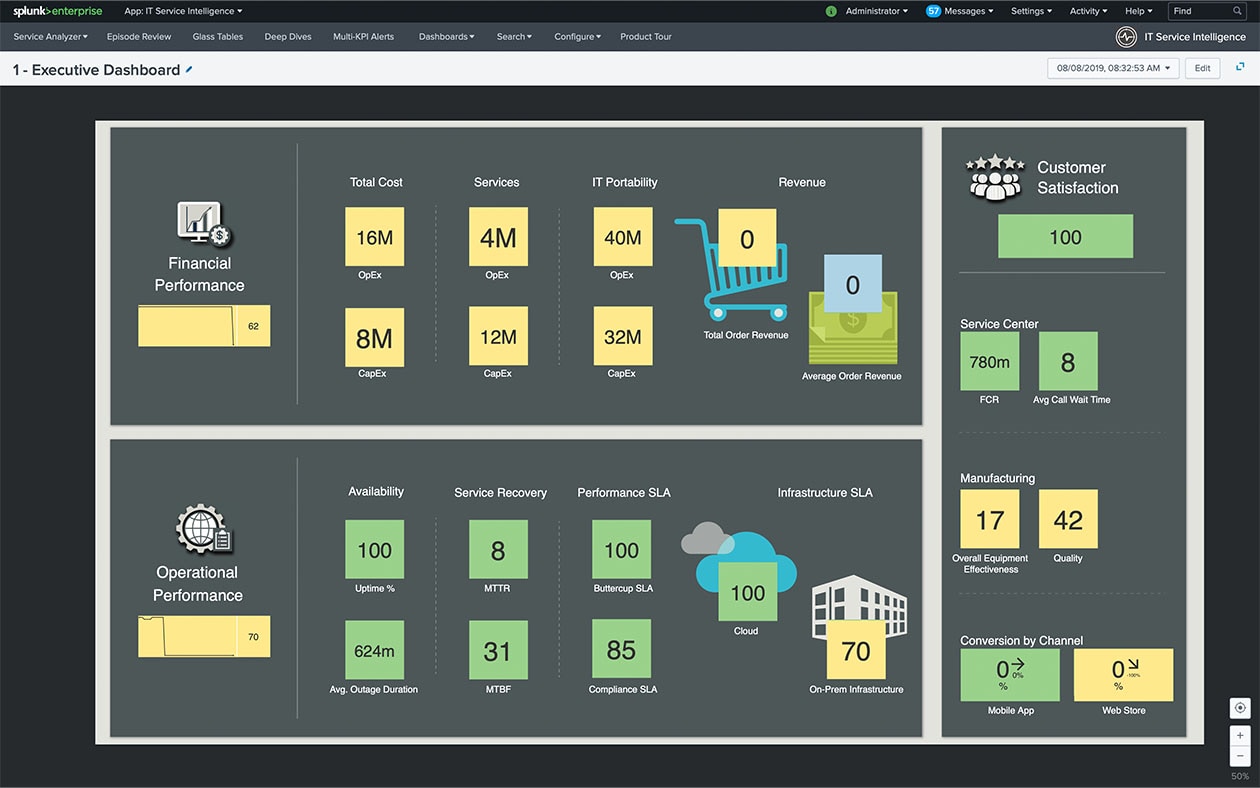 By Stephen Watts October 30, 2023
By Stephen Watts October 30, 2023
What is ITOM? Information technology operations management (ITOM) is the administration and management of an organization’s hardware, network, applications and technology needs. Generally regarded as the true meaning of “tech support,” it is a service-centric approach to IT infrastructure, IT support operations, IT networking and end user support.
At its core, IT operations management incorporates the provisioning and orchestration of IT infrastructure, performance management, security management, availability management, capacity management and cost control for all of an organization’s IT and network infrastructure and assets.
ITOM itself is a fluid, ever-evolving concept. The key to balanced and effective ITOM is not specifically technological, but rather methodology: understanding what best practices to apply and how to help organizations and their providers administer IT department functions. In particular, these best practices are meant to help IT provide more value to the organization and help achieve business goals.
In this article, we’ll define ITOM in more detail, explore why it’s important and outline ITOM best practices that you can apply to better serve and manage your IT operations environment.
The Importance of ITOM for Enterprises
ITOM is extremely important because it helps organizations improve workflows and increase the availability, proficiency and performance of IT operations, processes and services such as help desk, infrastructure and event management and configuration management. In short, ITOM helps establish processes that IT uses to deploy, implement and support services throughout their lifecycles.
ITOM also outlines how issues are remediated within an organization as standard practice, while providing faster resolutions. This helps businesses reduce the number of outages and ultimately improves user experience.
ITOM vs ITSM: What's the Difference?
Both ITOM and ITSM converge on several points, largely because they both manage IT service delivery.
ITSM (IT service management) is an umbrella term that has to do with how organizations use tools, processes, resources and frameworks to deliver quality services, both internally (to employees) and externally (to end users). Examples of ITSM processes include incident management, change management, IT asset management, service desk and service request management. Thus, it also relies on different frameworks compared to ITOM.
In general, while ITSM is about IT service delivery, ITOM is more focused on the management side of IT: service provision versus administration.
ITOM vs ITAM: What's the Difference?
Information technology asset management (ITAM) is an IT asset control methodology that includes the procurement and tracking of assets through the process of deployment, maintenance, retirement and disposal. ITAM examines the physical, financial, contractual and technological aspects of IT assets, which include hardware, software and applications. ITAM complements ITOM in that it provides real-time visibility into the organization's assets.
ITOM is self-serviced and can be used to prevent outages and maintain connectivity, provide operational agility and offer a clear view of IT infrastructure, both on-premises as well as with cloud or SaaS platforms. ITAM is the picture of everything around IT assets, whereas ITOM focuses on how assets are being used and how that may affect service availability.
IT Operations Management Best Practices
ITOM is the key to serving your organization’s technical needs; the upkeep of systems, applications and networks enables businesses to reach their goals and provides employees the tools they need for outstanding performance. Here are some best practices that help organizations successfully manage IT operations.
- Be proactive: IT operations professionals often find themselves in a permanent cycle of waiting for something to happen, putting out the fire and then fixing the problem. However, a “broken-now-fixed” mindset can be costly and dangerous in the current IT landscape. To get ahead of anticipated issues, organizations need to actively conduct preventative maintenance, and actively monitor and refine systems and processes, while aligning IT infrastructure and application management with current business goals.
- Set a variety of goals: IT teams, especially those in small businesses, often struggle to understand their priorities. For effective ITOM, IT professionals need to create goals and clearly define roles to which they can hold everyone accountable. Easy, short-term goals can give everybody a quick boost in morale, while long-term goals keep the team aligned and focused.
- Organize clear lines of communication: IT operations require effective communication to drive productivity and efficiency, and keep everyone aligned with business services toward common goals. Maintaining clear lines of communication ensures engagement and job satisfaction within the team and improves employee retention. Some ways to foster effective communication include:
- Create an open-door policy: A culture that encourages open communication is an effective way to build trust and encourage communication.
- Choose a method of communication that works for you: For some, that includes communication apps like Slack. For others, it could be consistent touch points, such as regular one-on-one meetings.
- Consider formal training in communications for your team.
- Always communicate individual responsibility clearly to avoid ambiguity.
- Get buy-in and support from the C-Suite: Modern ITOM is, at its heart, a strategic move that requires pivotal change in the organization. For it to succeed, organizations need sustained commitment from leadership and investment of IT resources. Because change often encounters friction, buy-in from the C-suite is imperative for channeling those resources. More importantly, support from the highest levels of leadership can help overcome initial resistance among the other teams and help prove that ITOM can help the organization achieve its goals and give the business an edge in the market, while also providing the required momentum to make it happen.
- Standardize and update your environment: Security and interoperability are two key factors that affect IT platform performance. The absence of standardized, checklist-style processes make it easy for administrators to inadvertently overlook some parts of the IT environment, creating new risks and bottlenecks throughout the environment. Standardization is achievable through processes such as ticketing, service calls and troubleshooting.
- Automate with AI and ML: Artificial intelligence (AI) and machine learning (ML) are already being employed in ITOM tools to automate simple tasks in IT. Using these advanced technologies in IT operations management software is one of the most effective ways to reduce the workload on IT teams and free them up to address high-priority tasks. Advanced ITOM software also alleviates the monotony of repetitive tasks that might be prone to errors. AIOps can also help support IT teams with analytics, patching, data storage and other critical functions.
- Adopt zero trust: Zero trust is already used heavily in cybersecurity, which is why it is important in both IT and service operations in general. As part of device management, it means strict access control across all endpoints by assuming that any user, IT asset, or resource is untrustworthy until verified. Thus, access must be granted continuously and only as needed. The architecture of a zero trust network needs to be highly customized, created around a set of protocols unique to the organization, while also requiring next-gen tools for mapping and data processing. It’s important to note that zero trust is more than an architecture — it’s a philosophy about security. Incorporating this mindset into an IT operations team is an important first step.
- Maintain company culture: IT systems rely on the inputs of everybody on the team. Empowering them through frequent feedback, open communication and regular training is important to keep the team’s skills and knowledge up to par. That said, friction caused by differences in culture and personal preferences can complicate collaboration. IT management needs to bring people together to align with the company’s culture and values. Keeping everyone on the same page will also help ensure that the C-suite remains supportive of your efforts.
- Bring IT and business together: Some IT reports on metrics and analytics are scarcely useful anywhere outside the IT department. The role of ITOM is to bring the technical and business sides of IT together, and ensure that reports and dashboards expand to demonstrate impact to the business’ bottom line. For instance, organizations can adjust reporting to be specific to ROI and revenue, allowing the team to demonstrate its direct impact on the business, while giving it a better chance of winning more budget resources.
- Invest in modern tools: According to a recent survey, 86% of IT operations teams are using at least some legacy infrastructure, such as outdated firewalls and aging desktops and laptops. Old equipment and software systems have big problems with reliability, compatibility, and bugs, making them a high cybersecurity risk. Modern tools and software can provide end-to-end observability while reducing complexity and downtime. Using modern ITOM tools can help organizations find issues and remediate faster by providing more in-depth metrics and speeding up processing times. Having full visibility into the stack will also enable IT teams with proactive management and analytics.

The Future of ITOM
As companies increasingly adopt automation and as IT staff are redirected to perform more sophisticated tasks, ITOM will be critical to IT operations, from maintenance to optimization. Automating ITOM for repetitive tasks, for example, can help mitigate inconsistencies, errors and other issues that occur with manual processes.
Also, because ITOM’s automation-based operations enable visibility and reach into other IT management processes such as ITAM and ITSM, IT professionals will be freed up to work on more complex, higher-value tasks.
ITOM automation will also continue to help organizations monitor alerts and initiate required security protocols when intruders enter the network or data center, when cyber threats arise, and/or when a server shuts down. To that end, AI collects operations data conveyed on dashboards and forecasts reports, allowing organizations to garner insights and make informed decisions to prevent future occurrences.
Wrapping Up: ITOM will future-proof your IT operations
Transforming ITOps for the future begins with insight into your entire IT infrastructure. ITOM best practices can instantly improve the value of your organization’s IT services. They can optimize IT processes to maximize the business value of the IT services you provide to your organization and enable your IT team to monitor and improve the health of your IT functions.
What is Splunk?
This posting does not necessarily represent Splunk's position, strategies or opinion.
